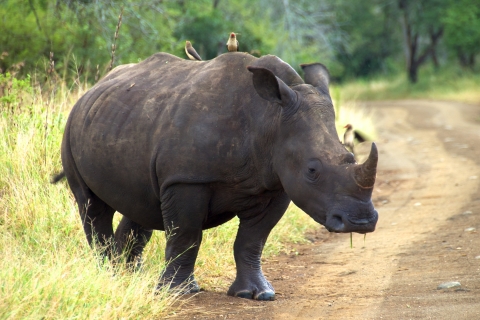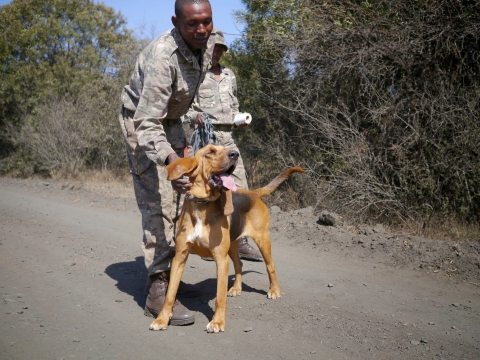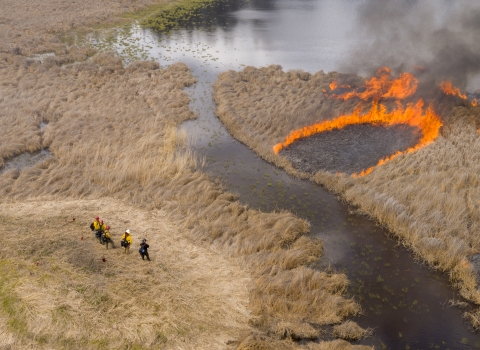How Americans Like You Have Helped Make This Project Possible
Projects such as this one would not be possible without the funding generated from proceeds of sales of the “Save Vanishing Species Semi-Postal Stamp,” also known as the “Tiger Stamp.” Through programs administered by the U.S. Fish and Wildlife Service, Tiger Stamps have helped fund projects that benefit tigers, sea turtles, great apes, rhinos, and elephants in 33 different countries. Since 2011, purchases of stamps have generated more than $6.5 million in funding for international conservation projects. Learn more and purchase tiger stamps from the U.S. Postal Service. Thank you for your support!
Outside, the rain is starting to fall, but the small house does not provide shelter for the on-duty ranger. Rain leaks through the 40 year-old, asbestos-ridden hatch roof. There is no electricity or hot water. Rusty pipes carry water to the facility and safe drinking water is not guaranteed. While the living conditions are typical, the ranger enforces more than regular park regulations. Part of a Rhino Protection Unit (RPU) in South Africa’s Hluhluwe-iMfolozo Park (HiP), the ranger is one of an incredible team of people protecting the park’s endangered rhino populations from poachers.
Hluluhwe-iMfolosi is synonymous with rhino conservation – it was here that South Africans found the last surviving population of southern white rhinos. Whereas international tourists come to KwaZulu-Natal (KZN) to see rhinos, poachers come to KZN in search of rhino horn. Although rhino horn is made of keratin, the same substance as human fingernails, poachers will kill rhinos for their horns because people mistakenly believe the horns have medicinal powers. By the early 1960s and 1970s, both black and white rhinos were hunted to dangerously low numbers throughout Africa. Threats to rhinos are so great that to minimize the information available to poachers, specific data on HiP’s rhino population is confidential.
However, through ambitious anti-poaching campaigns and reintroduction programs, the rhino population increased and was reintroduced to sites where rhinos had gone locally extinct. Thanks to good custodianship, dedicated individuals and strong political will, South Africa was able to increase its rhino population from fewer than 100 to more than 20,000 individuals. White rhino populations grew to the point that they became the founder population for all other southern white rhino populations in existence today. Field rangers patrol the park to provide on-the-ground protection for the rhinos. The rangers are committed to defending the park’s habitat and species, and enforcing regulations within the park. They are also able to arrest violators.
Unfortunately, the overwhelming price tag for greater enforcement on an already strained budget left many facilities understaffed or in disrepair. Little funding exists for facility repairs, let alone funding for equipment upkeep or for the rangers’ salaries. Instead, many rangers work long hours in difficult conditions for minimal pay. To defend the park, rangers have to forfeit time with their families in order to commit additional hours to patrol, often at night. A restful night’s sleep has become a luxury for the rangers. These conditions lower not only the rangers’ morale and comfort, but also their ability to effectively combat rhino poachers.
The rangers are effective, they just need more resources
Working with Save the Rhino International and ezemvelo KZN Wildlife, the U.S. Fish and Wildlife Service provided funds from Tiger Stamps for crucial repairs for the rangers’ equipment and facilities. The funds helped to renovate existing buildings and water supply facilities, and to pay for the installation of solar panels. Now, rangers are able to live in dry buildings equipped to provide them with safe drinking water, hot water, and electricity so that they are able to use small electric appliances. Additionally, the funds helped upgrade the rangers’ tracker dog kennels to improve living conditions and safety for the dogs.
While these changes improved the level of comfort and ranger morale, the funding also enhanced the rangers’ ability to protect rhinos. Funds from the Tiger Stamp helped purchase vehicles and equipment, such as a Toyota Hilux 4X4, new tires, and a new spotter plane. Rangers are now better able to monitor existing rhino populations by tracking the black rhinos, conducting number counts for white rhinos, and widening the scope of their land coverage for carcass detection. Better transportation has also increased the efficiency of ranger response teams and improved the ability of rangers to track poacher movements. The spotter plane especially has been effective in guiding ground teams towards rhinos in need, such as toward orphaned or poached rhinos. Reinvigorated, the rangers can deploy for longer, working to preserve the park’s rhino population and biodiversity as a whole.
Yet, the rangers continue to face challenges. Poaching in HiP has increased tenfold. Within the broader context of South Africa, poachers have shifted their focus towards KZN. Even with the improvements from the project, the rangers face safety concerns. The worsening situation will continue to strain the rangers and their resources, necessitating further assistance. The rangers have committed to helping keep rhinos safe. Our funds can help keep rangers safe.
This story was written by Deborah Kornblut, an intern with the Service’s International Affairs Program.





